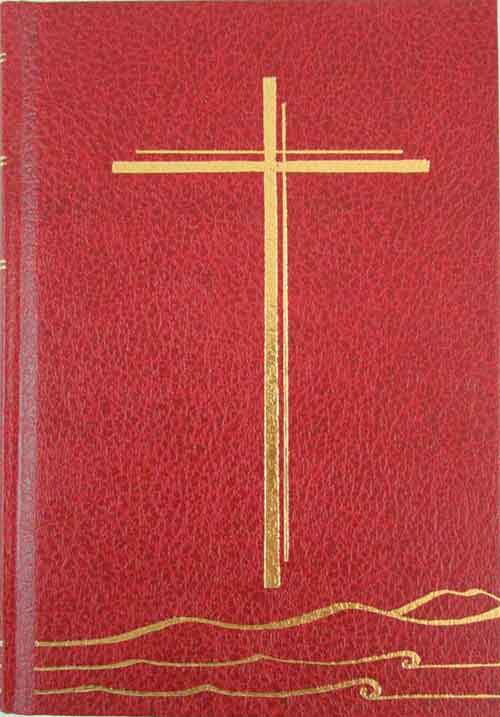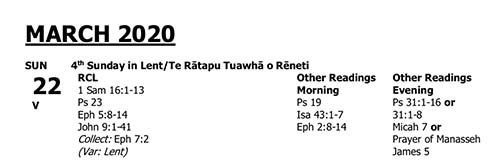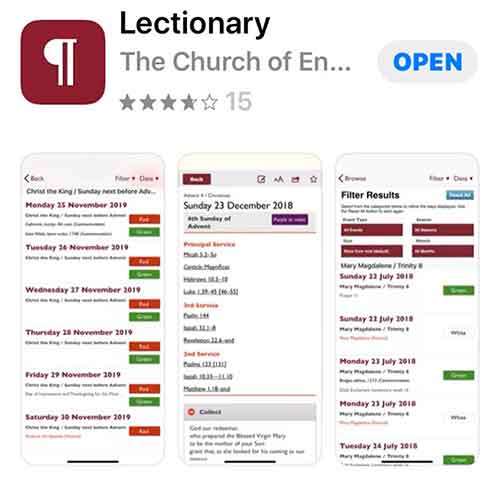
This post is to help people use the ‘Daily Services’ from A New Zealand Prayer Book He Karakia Mihinare o Aotearoa (ANZPBHKMA) at home. In the South Pacific, all people-present, public church services are suspended from Monday. The life of prayer in Christ continues.
That is the first, very important point. You are not praying alone. You are praying in Christ, as part of the Body of Christ. Even individually, Jesus teaches us to pray, “OUR Father…” The Daily Services in ANZPBHKMA (pages 54-103) are a form of the Daily Office (also referred to by other names: The Prayer of the Church, the Liturgy of the Hours,…) The Daily Office (in a variety of forms) is prayed by Christians across denominations and across time. You are inserting yourself into the Prayer of Christ – this is the very opposite of social isolation; this is spiritual fellowship and communion.
How to pray the Daily Services
You will need ANZPBHKMA, a Bible, and The Lectionary booklet. I will show you how to use online versions of each further in this post.

I will work through Sunday Morning (ANZPBHKMA page 58) . Put a ribbon in that page. In the Lectionary booklet, you will find the Morning Prayer and Evening Prayer information to be in the right two columns. So the set psalm is Psalm 19 (ANZPBHKMA pp 216-217). Put a ribbon in that page as well. I suggest, if you are only using 3 ribbons, put the third one for your collect [there are options for this collect; you could use one from Lent 4 (page 578) or the suggested Epiphany 7, the 2nd collect (p 569, “God of unchangeable power…”). You might like to add a couple of ribbons or thin card bookmarks for your Prayer Book (eg for pages 55-57). You might like to use some of the Thanksgivings and Intercessions ANZPBHKMA as a framework for your prayers and have them bookmarked (more on that below).
Now, in your Bible, put ribbons or bookmarks in the First Testament reading (Isa 43:1-7) and the New Testament reading (Eph 2:8-14).
If there is more than one of you, one of you leads. The word “minister” in ANZPBHKMA refers not to an ordained person, it is the person leading that particular part of any service in ANZPBHKMA. Bold type in ANZPBHKMA is what is said by the community. If you are praying alone, you say that also. If there is more than one person, the leader can also say the bold, or not – your call. If praying alone – your call to pray and read all aloud or not aloud.
If you are new to praying the office, it can feel stilted, unspontaneous, put on – but I encourage you to stick with it: you are praying inspired words, praying prayers prayed by Christians for 2,000 years, by Jesus, and by our Jewish cousins for millennia. It can be like new shoes that feel uncomfortable when we start walking in them – but after a while, look how much better and further we walk in them than without them…
After the opening sentence and response, you come to ‘The Song of Praise’. If there is more than one of you, you can say this aloud together (in unison), or in alternate verses (leader – rest; or half of the group – other half of the group). If you know how to chant, even better – you see the Song of Praise is ‘pointed’.
If there is more than one of you, the Psalm (in this case Psalm 19) is not recited in unison; it is prayed in alternate verses (leader – rest; or half of the group – other half of the group). Again, if you know how to chant, try that. Conclude the Psalm together: “Glory to the Father and…” (page 55).
The two readings follow. If possible, let others, not the leader, read these. You can conclude each with the usual “Hear what the Spirit is saying to the Church. Thanks be to God.” Also, don’t forget Te Reo options are provided throughout ANZPBHKMA. You can have silence; you can have discussion.
The second Song of Praise follows in the manner of the first.
The Apostles’ Creed (p 56), Lord’s Prayer (p 57), and A Collect of the Day (ribbon) follows.
A note about A Collect of the Day:
An important feast has its own collect. Wednesday, for example, is The Annunciation (25 March). Choose one of the collects on page 647 and use that.
For other saints’ days, you can use one of collects between pages 679 and 690. For example, Wednesday, 1 April, we celebrate ‘Frederick Denison Maurice, Priest, Theologian’. You could use a collect For a Teacher of the Faith (p 684), or For Any Saint (pp 686-7).
If you are not using a special collect for a day’s celebration, the tradition is to use the collect that you prayed on Sunday.
Thanksgivings and Intercessions
You can pray thanksgivings and intercessions extempore. You might have a list of people and things you are giving thanks for and praying for; you might have some cycles you work through, weekly, monthly, annually. You might use one of the ANZPBHKMA frameworks (with or without extempore prayer). Check out:
Page 50, 162, 163, 413, 416, 463, 482, 496,
The conclusion of the office follows.
The Evening Daily Service follows in the same way.
Adaptations
Start simple.
If you want to pray more psalms, you can follow the days given in ANZPBHKMA. Tomorrow morning would be “Day 22 Morning” (page 325). If, on the other hand, you want to make the service briefer, you could drop one of the Songs of Praise – creating a two-week cycle. If you only pray one office a day, you can have a two-week cycle with two Songs of Praise; or a four-week cycle with one Song of Praise. Some people want to pray the Benedictus (p 85) as the second Song of Praise every day in the morning, and the Magnificat (p 93) every evening – creating a two-week cycle for the first Song of Praise for each office. There are ‘Additional Songs of Praise’ (ANZPBHKMA pages 96-103), they can be used at any stage, but you will see that all but one has a seasonal subheading. Some people prefer to use the Daily Eucharistic Lectionary (DEL) instead of the readings I have pointed to above. DEL is the most-used Bible-reading discipline in the world. You could use one reading in the morning, another in the evening.
You can omit the Apostles’ Creed; you can omit the Self-Examination and Penitence.
You can add other devotions.
Digital Options
All this material is available online – you can open each resource you use; you can combine physical and digital resources. Here are the links:
A New Zealand Prayer Book He Karakia Mihinare o Aotearoa
The Lectionary Te Maramataka Year A 2020
The Bible online (NRSV)
Daily Eucharistic Lectionary (NRSV) and here
Daily Eucharistic Lectionary (Jerusalem Bible)
Daily Eucharistic Lectionary
and here and here
You might need to go to the next day in some of these examples that are resourced from, say, UK or USA.
There must be a link to the daily office readings – when I find such an example, it will be here.
Update: There is a Lectionary App for the Church of England which has the Daily Services readings:




I’m an Episcopal priest in Oregon. We frequently use your morning prayer and evening prayer. Your translation of the Lord’s Prayer is my favorite and we use it frequently – especially for services focused on Creation Care. Thank you! Thank you!